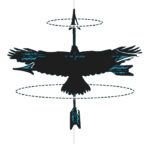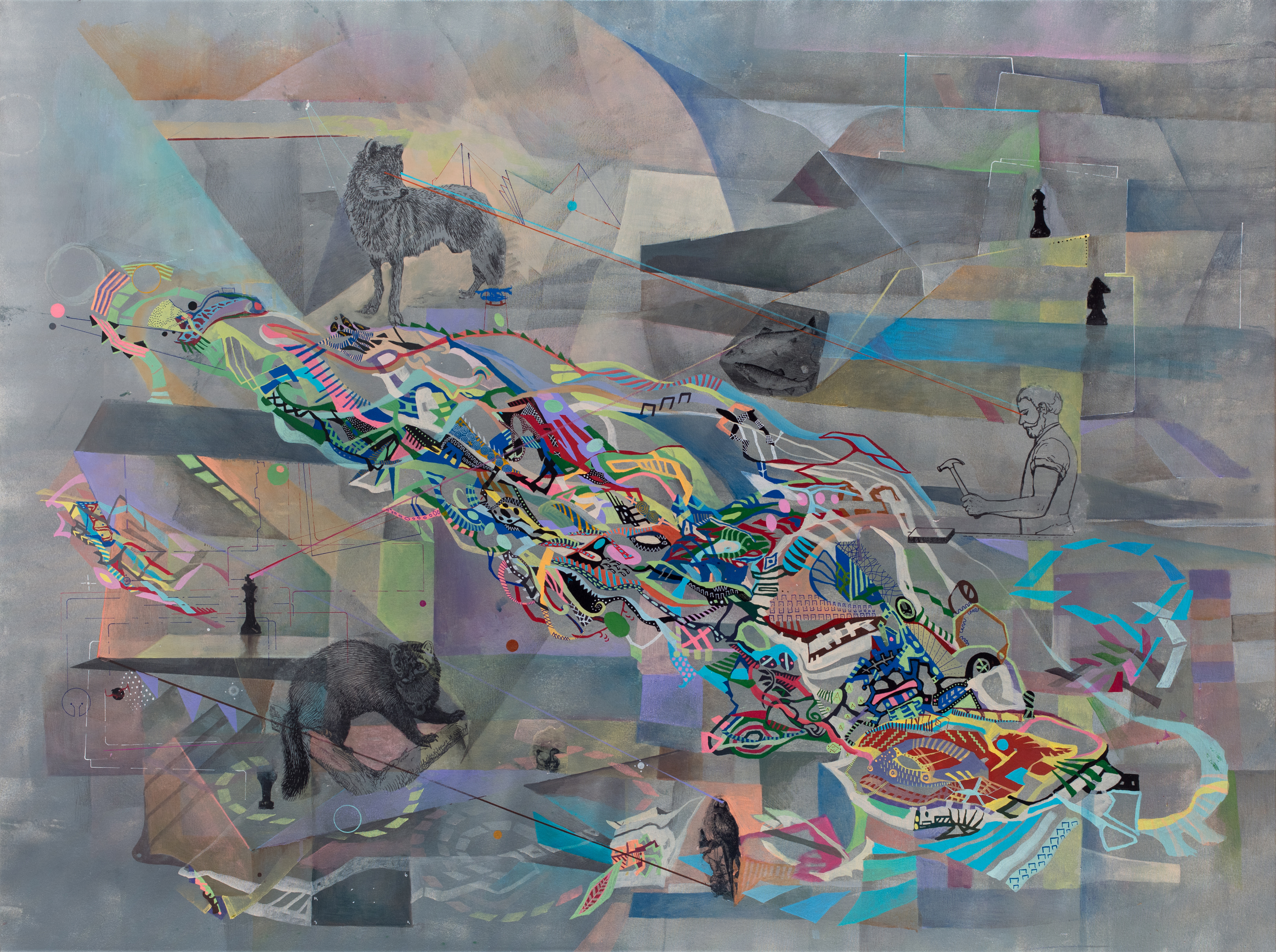The Distant Contour of Belief
Examine the thought closely. Scrutinize it–
its shape, its substance–
until it reveals itself to be the inauthentic thing it truly is. Look at its shadow, too thin for the solidity to which many attribute it and pitched at an unquestionable diagonal
even as the shadow of the thought situated
behind it is seen to be cast along the horizontal,
indicating the use of multiple artificial light sources
instead of the sole phosphorescence of cognizance some would have us suppose illumines the psyche’s otherwise dim terrain.
Notice the background. How dark it is–
devoid of any visible signal–
no way to calculate position or parallax and thereby determine the exact location of sentience if indeed an exact location can be determined. If there is anything to be discerned at all
it is the distant contour of belief, and rising alongside it
an identical contour, and another identical contour still
as if all have been forged from the same materials,
replicated and placed here in just such a manner as this in order to suggest a width and reach a cursory analysis will no doubt prove false.
Observe the banner. It is like a flag–
planted precariously in the loose soil of selfdom–
its arbitrary configuration of color and symbol rippling in the indisputable current of what a certain faction will have you believe is a vacuum
out of which idea is forged from an absolute
and memory preserved in totality
even as it becomes more and more likely personage
has been concocted on simulation’s stage. The evidence seems to point us here, to slipshod design and limited production means. How else to explain the lack of any definitive imprint existence ought to have created upon arrival?
False Flag
All the world’s a staged media event
and all of us mere crisis actors
effecting anger, outrage and hurt,
adopting the role of aggrieved
so many times over and over again
viewers can’t help but notice
similarities from one performance to the next,
repetition of the most minute gesture,
our various productions spliced together,
uploaded and titled for optimal SEO:
100% SCRIPTED HOAX EXPOSED
BUT HERE’S THE DEEPER AGENDA
An Object of Undoing
Okay I’ll explain it one last time. The ancient Sumerians
discovered the wheel. They domesticated cattle. They were
big into mathematics. These folks–the ancient Sumerians–
they basically invented written language. I don’t gotta
explain to you about cuneiform again, do I? These folks
they were big into astronomy, too. You understand me?
These folks mapped out the entire goddamn solar system
6,000 years ago, though you never were big on star maps
were you? Guess that’s the difference between you and me.
Thing is they mapped out ten planets instead of nine.
The tenth planet–well, that’s Nibiru. Nibiru’s got a diameter
roughly 4 times the size of Earth’s. Got an elliptical orbit, too,
what makes it so it don’t pass by here but once every
3,600 years. As for the planet’s surface there ain’t much to it
except for the pyramids the Annunaki left behind after
Nibiru’s atmosphere dissipated. Do I gotta explain
the entire history of the Annunaki again? What we
oughta focus on here is Nibiru’s core. Nibiru’s core’s
100 times denser than that of Earth’s and highly magnetized
to boot. When it comes swinging by Earth we’re
looking at a geomagnetic reversal so severe our
polarity’s gonna get flipped over on itself entirely. Expect
volcanic eruptions after that. Expect tsunamis coming
at you every which way. Expect a shit-ton of earthquakes.
Expect Y-class solar flares bombarding our ionosphere.
Hoping I don’t gotta explain the effect of Y-class solar flares
on the power grid down here. Hoping you understand when
I speak of two planetary objects what seem concocted
solely for one another’s destruction you understand what it is
I’m really getting at here. You do understand now
don’t you? According to Babylonian cosmology Nibiru means
a point of transition. An object of undoing is more accurate
but you never were big on ancient Akkadian languages were you?
The Divinity of Shape
What we know thus far: The six-sided vortex is unlike
anything else yet observed in the known universe,
so geometrically precise as to seem unreal
even if one takes into account that nature prefers the hexagonal form when it prefers distinct form at all
over,
for instance,
the ragged architecture by which existence otherwise appears to be structured.
That is to say, a distinction ought to be made between
the six carbon atoms which join six hydrogen atoms in order that a benzene molecule might be assembled
and the six-sided jet stream
approximately 22,000 miles in width.
Consider,
for example,
that each of the six sides of this geostrophic storm is far greater in size than our own planet’s diameter
and consider, too, that the winds of this storm
exceed that of 300mph, a velocity which otherwise
should annul the purity of lineation already discussed.
So it is we must examine the three-sided
triangle which can be discerned in certain images
situated improbably at the very center of this hexagonal vortex
in such a way it looks to have manifested itself in a configuration like that of an inverted pyramid. Likewise we must
examine
the two concentric circles
which are estimated to span roughly 1200 miles at their greatest
width and which appear to have been fashioned into the likeness of a behemothic eye
at the very center of this gaseous giant’s northern pole,
at the very center of this inverted pyramid.
Indeed, it is often referred to as the Eye of Saturn,
though some have voiced belief that it is,
in actuality,
the eye of God,
a divinity of shape which cannot be explained in terms other than a colossal oculus from which an implacable gaze is directed at man, the creator’s most inconstant creation. Still,
some merely think it a gateway to hell.
Some think it a portal out of which shall
one day come interstellar invasion.
A simpler theory, however, presents itself: If one
were to somehow pass through the center of this hexagonal vortex
one might find oneself nowhere at all. That is to say,
one might emerge in the void of deep space or perhaps issued into the darker and far more deeper void of oblivion
if the very concept of oblivion itself
isn’t negated by this phenomena entirely.
That is to say,
if an impossible geometry
can somehow be construed in this dominion here why shouldn’t the same be construed in that dominion there?
A hexagon itself is composed of tessellated
triangles. Tessellation occurs when a shape is repeated over and over again to such an extent that no gap or any overlap is allowed
thereby ensuring that neither energy
nor space is wasted during formation.
By this logic,
the very concept of a void
cannot be accounted for either by the principles of mathematics or those of science. In point of fact, why should we give any credence to the void at all?
—
Stephen Langlois is a recipient of a NYC Emerging Writers Fellowship from The Center for Fiction as well as a writing residency from the Blue Mountain Center. He also hosts
BREW: An Evening of Literary Works, a reading series held in Brooklyn, and serves as fiction editor for
FLAPPERHO– USE. His work has appeared in
Glimmer Train, Joyland, Lit Hub, Hobart, Maudlin House, 3AM Magazine, Barrelhouse, and
Split Lip Magazine, among others. Visit him at
stephenmlanglois.com.
Alexis Avlamis (b. Athens, 1979) is a painter influenced by the Surrealist’s Automatism. His work juxtaposes existing visuals with fabricated ones, leading to cosmographic mindscapes. His work has been exhibited and published internationally and is a Laureate of the International Emerging Artist Award in the Drawing and Illustration category.
Links
Website:
alexisavlamis.com
Instagram:
@alexisavlamis
Twitter:
@AlexiosAvlamis
This shortcode LP Profile only use on the page
Profile
